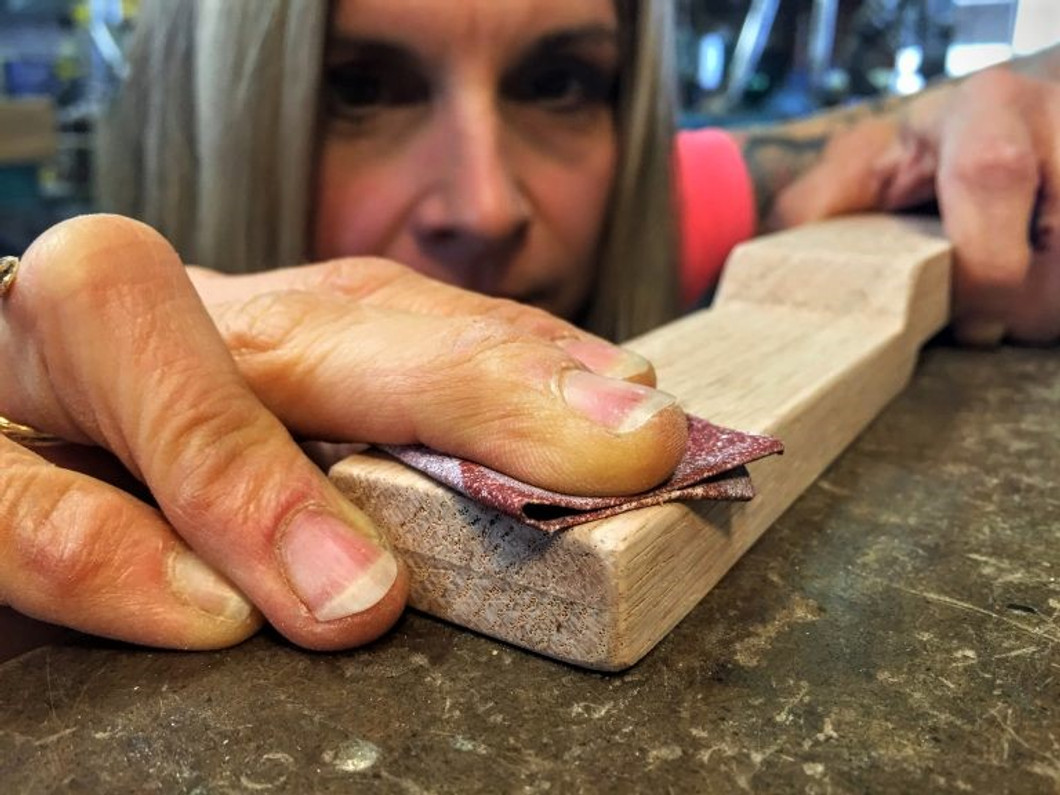End Your Search - Here's The Ultimate DIY Straight Headstock Guide You've Hungered For
A Step-by-Step Guide On How To Make a Straight Cigar Box Guitar Headstock With Tools You Already Own
We all know how popular those angled scarf-joint headstocks are, how useful the design is, and how good they look.
But even with all those good reasons to build with them, if all you've got is a few common hand tools, scarf joint-headstocks can be really difficult to make.
Instead, why not use a straight headstock on your next build?
And not just any old straight headstock, but the ultimate DIY straight headstock that you can make with a few common hand tools you already have.
If that's not reason enough to convince you to use this guide for your next cigar box guitar (CBG), this straight headstock design offers
- ease of use - no special jigs required!
- thoughtful design - ideal string break-angle for proper tension which prevents string buzz and rattle
- clean lines - fit the overall DIY CBG aesthetic
Using this guide, you’re going to see just how easy it is to use simple tools to make a straight headstock that perfectly marries form and function.
First, let's start with the handful of tools you'll need.
Tools needed
- Square
- Small handsaw
- Clamps
- File / rasp
- Wood glue
- Sandpaper (coarse and fine grits)
As mentioned earlier, as a cigar box guitar builder, even one of humble means (like me), you likely already have these tools.
And even if you're missing one, you're sure to find it in a friend's toolbox or down at the local dollar store.
The only other things you need are a pencil and a length of lumber (preferably hardwood measuring 3/4-inch [19mm] by 1 & 1/2-inch [38mm]).
For less than the cost of a fancy drive-through window coffee drink, you can get yourself a nice, straight piece of maple, red oak, or poplar hardwood from lots of different home improvement stores.
Then, after you have your tools and materials together, it's time to lay out your headstock.
Lay out headstock
Start by looking at your neck lumber and decide which end will be the top-end (the headstock) and which 1 & 1/2-inch (38mm) surface will be front-facing (the front of the headstock).
Next, place the neck on its side.
From the top-end of the neck, measure down 5-inches (127mm). Mark that spot on the side of the neck.
While you’re at it, measure down 5 & 1/4-inches (133mm) and mark the spot, too.
In a few moments, you'll use these two marks to layout the bottom of the headstock.

Now, with the neck still on its side, go back to the top-end.
From the front-facing surface, measure down 5/16-inch (8mm) and mark that spot on the side of the neck.
Then, go back to the marks you've drawn for the bottom of the headstock.
At the 5-inches (127mm) mark, measure down from the front-facing surface 5/16-inch (8mm) and mark the spot where the two measurements intersect.

Using your square, draw a line from the top of the mark at 5 & 1/4-inches (133mm) to the intersected spot you’ve just marked.
This angled line is the bottom beveled edge of your headstock.
Next, go ahead and draw a line that connects the two marks on the side of the neck that measures 5/16-inch (8mm) down from the front-facing surface.

Repeat all the same marks and lines on the other side of the neck.
Then, at the top of the neck (soon-to-be headstock), draw a line to connect the marks on both sides of the neck drawn 5/16-inch (8mm) down from the front-facing surface.

And for the last line, on the front-facing part of the neck, connect the spots marked on both sides at 5 & 1/4-inches (133mm) from the top-end.
These lines illustrate what will be cut out to expose the front of the headstock.
Once your headstock is done, install our most popular tuners with that classic open-gear look.
Chrome Open-Gear Economy Tuners/Machine Heads
Cut it out
Given that cuts such as the ones you are about to make are done free-hand (without a jig), they can be challenging to produce perfectly straight lines.
While not absolutely necessary, I recommend that you try one or two of the following cuts on a scrap piece of wood, just to get the hang of the motions.
Now, about that headstock...
For safety’s sake, clamp the neck down to your work surface, nice and tight. You’re about to get down to business.
At the line drawn 5 1/4-inches (133mm) down from the top of the neck, use your small hand saw to make a shallow cut.
Your square may come in handy here – hold it against the line to help keep the saw blade straight.
After you’ve made your shallow cut, angle your handsaw to match the angled line on the side of the neck. With slow, deliberate strokes, cut along that angled line.
If your saw doesn't have a rigid spine, use your free hand to hold the top of the blade. This will keep the saw steady and straight while you make your cut.

Stop your cut just as you meet the line that is the front of your headstock.
Now, take your saw to the top of the neck. Slowly score the line you’ve drawn at the top.
Then use slow and deliberate strokes to cut along the lines on the sides of the neck.
Keep your saw on track by keeping an eye on the lines those lines.
This is some of the trickiest work you’ll do, but fret naught!
Even if it runs off course a wee bit, you can remove the saw and adjust it to straighten the cut.

As an alternative, you can also re-position the neck to cut the headstock.
Try clamping the neck on its side with the headstock hanging off your work surface. In this way, you can use your saw in a vertical position.
For peace of mind, remember that even if the cut comes out rough, you’ll have plenty of time to file and sand it smooth.
After you make that long cut, make sure to keep the cut-out. In the next series of steps, you'll glue that cut-out to the back of the headstock.

Glue it together
Flip the neck, so the back of it is facing up.
Also, flip the headstock cut-out so that the smooth side is facing up.
Apply wood glue on the smooth side of the cut-out and the back of the headstock.
To ensure even application, use your finger or a clean rag to spread the glue around on both surfaces.
Then, flip the cut-out over and place it onto the back of the headstock, with the beveled edge pointed towards the tail-end of the neck, so that both glued surfaces face each other.
Slide the cut-out around to help tighten the bond with the headstock.

Position the cut-out so that it and the neck make a joint that is as thick as the neck itself.
So, if your cigar box guitar neck is 3/4-inch (19mm) tall, position the cut-out to create a 3/4-inch (19mm) joint with the headstock.
Clamp the cut-out to the headstock nice and tight, wipe off any excess glue that squeezed out, and let it sit for as long as the glue manufacturer recommends.

Did you wait for the recommended drying time before removing the clamps?
Good.
It’s tough to find the patience to let wood glue dry when all you want to do is finish building your CBG.
But the longer you can wait, the stronger that straight headstock joint will be.

After you remove the clamps, you can shape and smooth your headstock.
You can fret that neck of yours using Ben "Gitty" Baker's own 159-page fretting guide.
Homemade Instrument Fretting Handbook by Ben "Gitty" Baker - Complete Cigar Box Guitar Fretting How-to Guide
Make it smooth
Firmly clamp your neck on its side to your work surface.
Use your handsaw to cut off the little overhang left at the top of your headstock.
To protect your work surface, consider putting a scrap piece of wood between the neck and the bench.
The scrap wood will prevent you from gouging your bench, or worse, your kitchen table, if that's what you're using (no shame! I've used my kitchen table, too.)

With that cut made, you’re on the home stretch, now.
On the front and back of your headstock, use your rasp and file to smooth the roughest areas.
Next, sand the headstock to as smooth as you like. Start with coarse grit and finish up with fine-grit sandpaper.

80 to 100 grit sandpaper is good for the rough stuff, and 220 grit works well to finish, but how fine you go with your sandpaper is up to you.
The longer you spend sanding, and the finer the grit you use, the smoother your headstock will look and feel.

That's a really cool headstock you have!
So there you are with your brand-new, highly functional and gorgeous straight headstock.
As you can see, with
- this simple, yet powerful, step-by-step guide
- and just a handful of tools you already own
you can break out of the mold and build something unique and useful you've been hungering for.
What will the rest of your build look like?
Want to take it further?
How To Cut Perfect Cigar Box Guitar Scarf Joints By Hand
Now that you've mastered the straight headstock, how about trying the angled, or scarfed, headstock?
In this post, you'll learn how to cut perfect scarf joints by hand!
Recent Posts
-
2024 World's Wildest Electric Cigar Box Guitar Build-Off Winners!!!
C. B. Gitty Crafter Supply is proud to announce the winners of the 2024 "World's Wildest Electric Ci …31st Oct 2024 -
Improved C. B. Gitty: Easier Than Ever! (Work in Progress)
Ben “Gitty” has been cleaning house, making our website even easier find your favorite parts, kits a …7th Oct 2024 -
Build-Off Contest 2024: The World's Wildest ELECTRIC Cigar Box Guitar
CBGitty.com is looking for the WILDEST, LOUDEST & MOST DIABOLICAL electric cigar box guitar ever …6th Sep 2024







